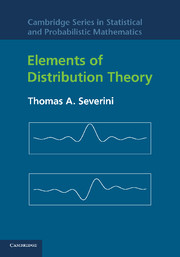Book contents
- Frontmatter
- Contents
- Preface
- 1 Properties of Probability Distributions
- 2 Conditional Distributions and Expectation
- 3 Characteristic Functions
- 4 Moments and Cumulants
- 5 Parametric Families of Distributions
- 6 Stochastic Processes
- 7 Distribution Theory for Functions of Random Variables
- 8 Normal Distribution Theory
- 9 Approximation of Integrals
- 10 Orthogonal Polynomials
- 11 Approximation of Probability Distributions
- 12 Central Limit Theorems
- 13 Approximations to the Distributions of More General Statistics
- 14 Higher-Order Asymptotic Approximations
- Appendix 1 Integration with Respect to a Distribution Function
- Appendix 2 Basic Properties of Complex Numbers
- Appendix 3 Some Useful Mathematical Facts
- References
- Name Index
- Subject Index
Appendix 3 - Some Useful Mathematical Facts
Published online by Cambridge University Press: 27 October 2009
- Frontmatter
- Contents
- Preface
- 1 Properties of Probability Distributions
- 2 Conditional Distributions and Expectation
- 3 Characteristic Functions
- 4 Moments and Cumulants
- 5 Parametric Families of Distributions
- 6 Stochastic Processes
- 7 Distribution Theory for Functions of Random Variables
- 8 Normal Distribution Theory
- 9 Approximation of Integrals
- 10 Orthogonal Polynomials
- 11 Approximation of Probability Distributions
- 12 Central Limit Theorems
- 13 Approximations to the Distributions of More General Statistics
- 14 Higher-Order Asymptotic Approximations
- Appendix 1 Integration with Respect to a Distribution Function
- Appendix 2 Basic Properties of Complex Numbers
- Appendix 3 Some Useful Mathematical Facts
- References
- Name Index
- Subject Index
Summary
This appendix contains a review of some basic mathematical facts that are used throughout this book. For further details, the reader should consult a book on mathematical analysis, such as Apostal (1974), Rudin (1976), or Wade (2004).
Sets
Basic definitions. A set is a collection of objects that itself is viewed as a single entity. We write x ∈ A to indicate that x is an element of a set A; we write x ∉ A to indicate that x is not an element of A. The set that contains no elements is known as the empty set and is denoted by ø.
Let A and B denote sets. If every element of B is also an element of A we say that B is a subset of A; this is denoted by B ⊂ A. If there also exists an element of A that is not in B we say that B is a proper subset of A. If A and B have exactly the same elements we write A = B. The difference between A and B, written A \ B, is that set consisting of all elements of A that are not elements of B.
Set algebra. Let S denote a fixed set such that all sets under consideration are subsets of S and let A and B denote subsets of S. The union of A and B is the set C whose elements are either elements of A or elements of B or are elements of both; we write C = A ∪ B.
- Type
- Chapter
- Information
- Elements of Distribution Theory , pp. 483 - 502Publisher: Cambridge University PressPrint publication year: 2005



